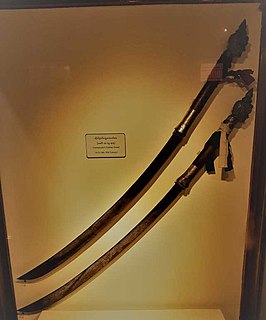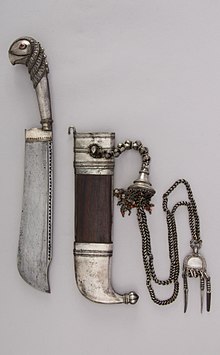The yatagan or yataghan is a type of Ottoman knife or short sabre used from the mid-16th to late 19th centuries. The yatagan was extensively used in Ottoman Turkey and in areas under immediate Ottoman influence, such as the Balkans and the Caucasus.

The kampilan also known as talong is a type of single-edged sword, traditionally used by various ethnic groups in the Philippine archipelago. It has a distinct profile, with the tapered blade being much broader and thinner at the point than at its base, sometimes with a protruding spikelet along the flat side of the tip. The design of the pommel varies between ethnic groups, but it usually depicts either a bakunawa (dragon), a buaya (crocodile), a kalaw (hornbill), or a kakatua (cockatoo).

The term Kodava (ಕೊಡವ) has two related usages. Firstly, it is the name of the Kodava language and culture followed by a number of communities from Kodagu. Secondly, within the Kodava - speaking communities and region (Kodagu) it describes the dominant Kodava people. The Kodavas, are considered a patrilineal ethno-lingual tribe from the region of Kodagu,, who natively speak the Kodava language. Traditionally they are land-owning agriculturists with martial customs. Kodavas are the only people in India permitted to carry firearms without a license.

Seax is an Old English word for "knife". In modern archaeology, the term seax is used specifically for a type of small sword, knife or dagger typical of the Germanic peoples of the Migration period and the Early Middle Ages, especially the Saxons, whose name derives from the weapon. These vary considerably in size, but are mostly all-purpose tools and weapons, often carried by women as well as men.

Japanese sword mountings are the various housings and associated fittings (tosogu) that hold the blade of a Japanese sword when it is being worn or stored. Koshirae (拵え) refers to the ornate mountings of a Japanese sword used when the sword blade is being worn by its owner, whereas the shirasaya is a plain undecorated wooden mounting composed of a saya and tsuka that the sword blade is stored in when not being used.

The shashka or shasqua, is a kind of sabre; single-edged, single-handed, and guardless backsword. In appearance, the shashka is midway between a typically curved sabre and a straight sword. It has a slightly curved blade, and can be effective for both cutting and thrusting.

On a sword, the crossguard, or cross-guard, also known as quillon, is a bar of metal at right angles to the blade, placed between the blade and the hilt. The crossguard was developed in the European sword around the 10th century for the protection of the wielder's hand. The earliest forms were the crossguard variant of the Spatha used by the Huns, the so-called Pontic swords. There are many examples of crossguards on Sasanian Persian Swords beginning from the early 3rd century. They might be the oldest examples. The crossguards were not only used to counter enemy attacks, but also to get a better grip on the sword. They were later seen in late Viking swords, and is a standard feature of the Norman sword of the 11th century and of the knightly arming sword throughout the high and late medieval period. Early crossguards were straight metal bars, sometimes tapering towards the outer ends. While this simple type was never discontinued, more elaborate forms developed alongside it in the course of the Middle Ages. The crossguard could be waisted or bent in the 12th and 13th century.

Dha is the Burmese word for "knife" similar term to daab or darb in Thai language for a single edge sword. The term dha is conventionally used to refer to a wide variety of knives and swords used by many people across Southeast Asia, especially present-day Myanmar (Burma), Thailand, Yunnan, Laos, Cambodia and Vietnam.

Mandau is the traditional weapon of the Dayak people of Borneo. It is also known as Parang Ilang among the Bidayuh, Iban and Penan people, Malat by the Kayan people or Baieng by the Kenyah people or Bandau by Lun Bawang or Pelepet/Felepet by Lundayeh. Mandau is mostly ceremonial. However, a less elaborate version called Ambang is used as an everyday practical tool.

The Model 1840 noncommissioned officers' sword was adopted by the United States military in 1840. Based primarily on a sword used by the French Army, the model 1840 NCO proved somewhat heavy hilted and ill balanced. For over 70 years, it was widely used by the Army; today its usage is restricted to ceremonial occasions. The sword had a 31-inch blade, a cast brass hilt resembling the more expensive wire-wrapped leather grips, and a leather scabbard rather than the steel used by cavalry troopers and officers, although some makers, such as Emerson and Silver, issued a steel scabbard rather than leather to protect from wear. Leather scabbards were phased out beginning in 1868.

The pattern 1796 Heavy Cavalry Sword was the sword used by the British heavy cavalry, and King's German Legion Dragoons, through most of the period of the Revolutionary and Napoleonic Wars. It played an especially notable role, in the hands of British cavalrymen, at the battles of Salamanca and Waterloo. The pattern was adopted by Sweden and was used by some Portuguese cavalry.

The Seax of Beagnoth is a 10th-century Anglo-Saxon seax. It was found in the inland estuary of the Thames in 1857, and is now at the British Museum in London. It is a prestige weapon, decorated with elaborate patterns of inlaid copper, brass and silver wire. On one side of the blade is the only known complete inscription of the twenty-eight letter Anglo-Saxon runic alphabet, as well as the name "Beagnoth" in runic letters. It is thought that the runic alphabet had a magical function, and that the name Beagnoth is that of either the owner of the weapon or the smith who forged it. Although many Anglo-Saxon and Viking swords and knives have inscriptions in the Latin alphabet on their blades, or have runic inscriptions on the hilt or scabbard, the Seax of Beagnoth is one of only a handful of finds with a runic inscription on its blade.

Kastane is a short traditional ceremonial/decorative single-edged Sri Lankan sword.

Wedung is a traditional large knife of the Javanese people and the Balinese people originating from Indonesia.

Gari is a sword that originates from Nias, an island off the west coast of North Sumatra, Indonesia. It is a term used for a type of sword found only in North Nias.

Si Euli is a traditional dagger or knife that originates from Nias, an island off the west coast of North Sumatra, Indonesia. There are versions of this knife worn by men or for daily use.

The piha kaetta, also sometimes called 'the Kandyan knife', is a knife or dagger native to the island of Sri Lanka. A typical piha kaetta has a straight-backed blade combined with a drop-point and a curved cutting edge. Many of the finest piha kaetta knives were produced in royal workshops, show very high levels of craftsmanship, and were given to courtiers and the nobility as status symbols.

Pisau raut is a whittling knife that is commonly as a tool to prepare the rattan and other fine carving found throughout the entire Malay archipelago. It is well known as an accompanying knife placed in the same sheath with the mandau, a traditional weapon of the Dayak people.
Odi katti is an indigenous weapon of war and tools to the Kodava people of Kodagu, in the state of Karnataka, India. The ayudha katti is developed from an implement used to cut through dense undergrowth. Unlike most blades, the odi katti is worn without a sheath.
The Pattern 1831 sabre for General Officers is a British army pattern sword prescribed for the use of officers of the rank of major-general and above. It has been in continuous use from 1831 to the present. It is an example of a type of sword described as a mameluke sabre.


















